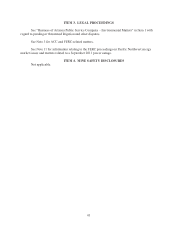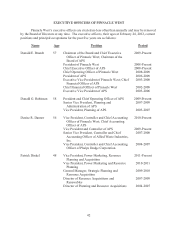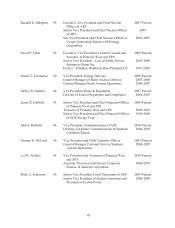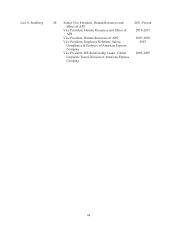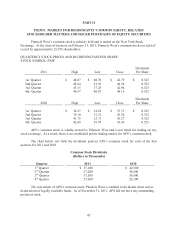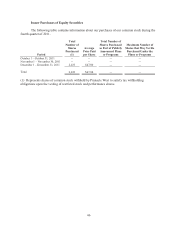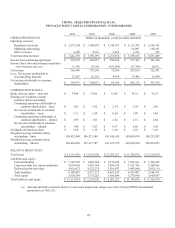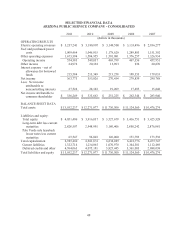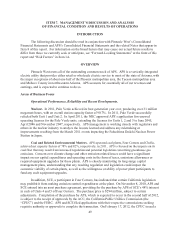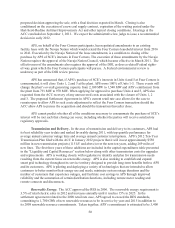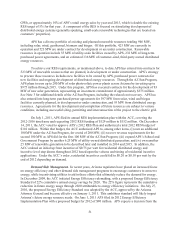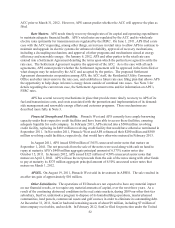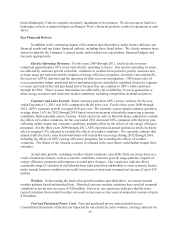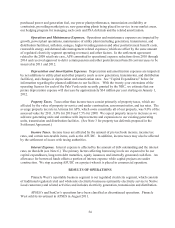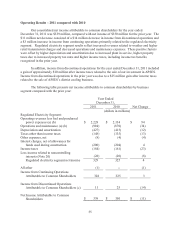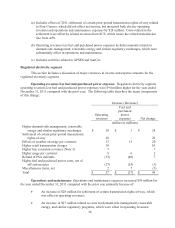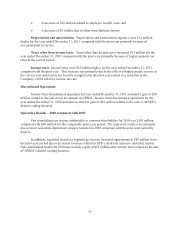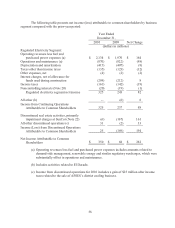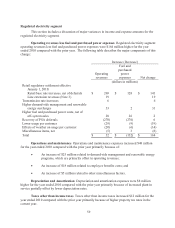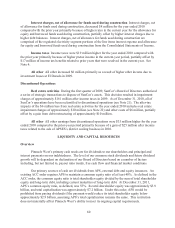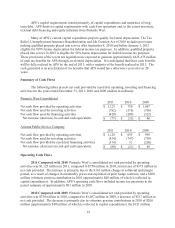APS 2011 Annual Report Download - page 75
Download and view the complete annual report
Please find page 75 of the 2011 APS annual report below. You can navigate through the pages in the report by either clicking on the pages listed below, or by using the keyword search tool below to find specific information within the annual report.51
GWh, or approximately 10% of APS’s retail energy sales by year-end 2015, which is double the existing
RES target of 5% for that year. A component of the RES is focused on stimulating development of
distributed energy systems (generally speaking, small-scale renewable technologies that are located on
customers’ properties).
APS has a diverse portfolio of existing and planned renewable resources totaling 946 MW,
including solar, wind, geothermal, biomass and biogas. Of this portfolio, 423 MW are currently in
operation and 523 MW are under contract for development or are under construction. Renewable
resources in operation include 55 MW of utility-scale facilities owned by APS, 232 MW of long-term
purchased power agreements, and an estimated 136 MW of customer-sited, third-party owned distributed
energy resources.
To achieve our RES requirements, as mentioned above, to date APS has entered into contracts for
523 MW of renewable resources that are planned, in development or under construction. APS’s strategy
to procure these resources includes new facilities to be owned by APS, purchased power contracts for
new facilities and ongoing development of distributed energy resources. Through the AZ Sun Program,
APS plans to own up to 200 MW of solar photovoltaic power plants across Arizona by investing up to
$975 million through 2015. Under this program, APS has executed contracts for the development of 83
MW of new solar generation, representing an investment commitment of approximately $375 million.
See Note 3 for additional details of the AZ Sun Program, including the related cost recovery. APS has
also entered into long-term purchased power agreements for 397 MW from solar, wind and biogas
facilities currently planned, in development or under construction, and 93 MW from distributed energy
resources. Agreements for the development and completion of future resources are subject to various
conditions, including successful siting, permitting and interconnection of the project to the electric grid.
On July 1, 2011, APS filed its annual RES implementation plan with the ACC, covering the
2012-2016 timeframe and requesting 2012 RES funding of $129 million to $152 million. On December
14, 2011, the ACC voted to approve APS’s 2012 RES Plan and authorized a total 2012 RES budget of
$110 million. Within that budget, the ACC authorized APS to, among other items, (i) own an additional
100 MW under the AZ Sun Program, for a total of 200 MW; (ii) recover revenue requirements for the
second 100 MW as APS did for the first 100 MW of the AZ Sun Program; (iii) expand APS’s School and
Government Program by another 6.25 MW of utility-owned distributed generation; and (iv) own another
25 MW of renewable generation to be described later and installed in 2014 and 2015. In addition, the
ACC ordered an initial up front incentive of $0.75 per watt for residential distributed energy and
incentive level step downs throughout 2012 based upon the volume and timing of residential incentive
applications. Under the ACC’s order, residential incentives could fall to $0.20 or $0.10 per watt by the
end of 2012 depending on demand.
Demand Side Management. In recent years, Arizona regulators have placed an increased focus
on energy efficiency and other demand side management programs to encourage customers to conserve
energy, while incentivizing utilities to aid in these efforts that ultimately reduce the demand for energy.
In December 2009, the ACC initiated Energy Efficiency rulemaking, with a proposed Energy Efficiency
Standard of 22% cumulative annual energy savings by 2020. The 22% figure represents the cumulative
reduction in future energy usage through 2020 attributable to energy efficiency initiatives. On July 27,
2010, the proposed Energy Efficiency Standard was adopted by the ACC, approved by the Arizona
Attorney General and became effective on January 1, 2011. This ambitious standard will likely impact
Arizona’s future energy resource needs. On June 1, 2011 APS filed its 2012 Energy Efficiency
Implementation Plan with a proposed budget for 2012 of $90 million. APS expects a decision from the


